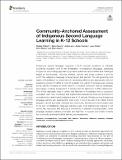Community-anchored assessment of Indigenous second language learning in K-12 schools

View Open
Metadata
Show full item recordAuthor
Tulloch, Shelley
Moore, Sylvia
Lane, Jodie
Townley, Sarah
Dicker, Joan
Boase, Doris
Adams, Ellen
Date
2022Citation
Tulloch, S., Moore, S., Lane, J., Townley, S., Dicker, J., Boase, D., & Adams, E. (2022). Community-anchored assessment of Indigenous second language learning in K-12 schools. Frontiers in Education, 7.
Abstract
Indigenous second language programs in K-12 schools contribute to culturally nourishing education and to the revitalization of Indigenous languages. Assessing Indigenous second language learning presents particular opportunities and challenges based on the linguistic, historical, political, cultural, and social contexts in and for which the Indigenous language is being taught and learned. The self-governing Inuit region of Nunatsiavut is concerned with developing effective and appropriate tools for assessing students’ Inuttitut in order to evaluate how well K-12 programs are working so far, identify the basis on which future K-12 Inuttitut curriculum may be developed, and support ongoing assessment of learning and for learning in Inuttitut classrooms. This article discusses ways in which Inuit teachers in Nunatsiavut and a curriculum evaluation team have developed and implemented assessment tools and practices to evaluate Inuttitut learning in Nunatsiavut area K-12 schools. We discuss how Indigenous language learning and assessment, even when it occurs as part of an official school program, can be anchored in families and community. Families and communities need to be part of establishing language learning goals. Inuit teachers are drawing in full community resources and building a community of practice including Elders, other language speakers, leaders, principals, and teachers, to support and create contexts for community-anchored Inuttitut learning and assessment.
